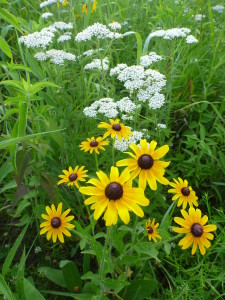Prairies For Agriculture Project
Benefiting Farms and Nature
Central College, Pella, Iowa
Quiz Question 1. True or False: Tallgrass Prairie is one of the most endangered ecosystems on earth.
Answer: True. Although Tallgrass Prairies used to blanket thousands of square miles of central North America, less than 4% of this ecosystem remains1. In states such as Iowa and Illinois, less than 0.1% of Tallgrass Prairies remain, and the few remaining small patches face enormous problems.
Quiz Question 2. True or False: Birds that inhabit Midwestern grasslands have stable or increasing populations because they can survive and nest in agricultural fields.
Answer: False. Grassland birds are declining in numbers faster than any other group of birds in North America2. Familiar birds such as Eastern & Western Meadowlarks, Grasshopper Sparrows, Dicksissels, Bobolinks and others are declining because the large grasslands they need to survive are disappearing.
Quiz Question 3. Can Tallgrass Prairies be restored in a way that benefits agriculture and other sectors of society in addition to helping nature?
Answer: Keep reading because that is the question we will study over the next 25 years with Central College’s Prairies For Agriculture Project.
Tallgrass Prairies used to cover a huge portion of North America, from Indiana west to Nebraska, and from Canada south to Texas. This ecosystem built the incredible soils that support the “Breadbasket of the World,” yet most Midwesterners know very little about it because so little tallgrass prairie remains. But recent research hints that DIVERSE plantings of prairie vegetation can provide many benefits to agriculture and other aspects of society. For instance, prairies store large quantities of carbon in the soil, potentially slowing climate change; prairies create huge amounts of biomass for fuel production or feeding livestock; prairies likely support large numbers of pollinators and other beneficial insects within the agricultural landscape; and prairies slow soil erosion and absorb excess phosphorus and nitrogen from fertilizers before they create environmental problems. With more work investigating and demonstrating these benefits, we may be able to  recreate this beautiful ecosystem, creating a rare win-win for nature AND humans.
recreate this beautiful ecosystem, creating a rare win-win for nature AND humans.
The Prairies for Agriculture Project will examine the many benefits of prairie. Using over 350 plots planted with different mixes of vegetation, we will test whether prairie plants provide more benefits than the non-native species commonly grown on un-farmable sites in the agricultural landscape. We also will test whether increasing the diversity of prairie plantings from one to 64 species increases the benefits provided. Furthermore, our research area, located near Pella, Iowa, will be used as a demonstration site so that agricultural producers, government leaders, and members of the public can learn about prairie and the benefits it can provide. Lastly, since much of the work, data collection, and statistical analysis for our project will be conducted by undergraduates at Central College, the Prairies For Agriculture Project will provide unparalleled educational opportunities for students.
Follow the links below to learn more.


